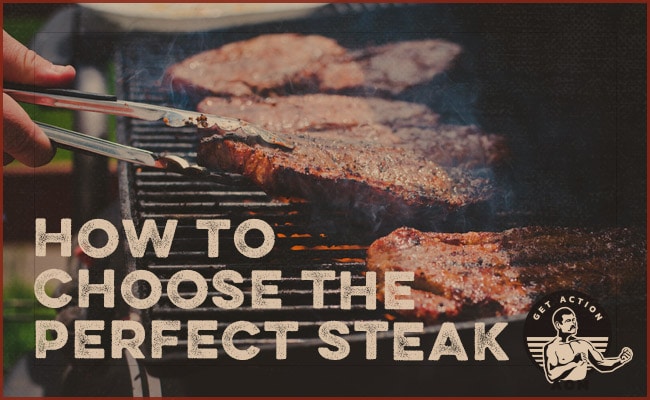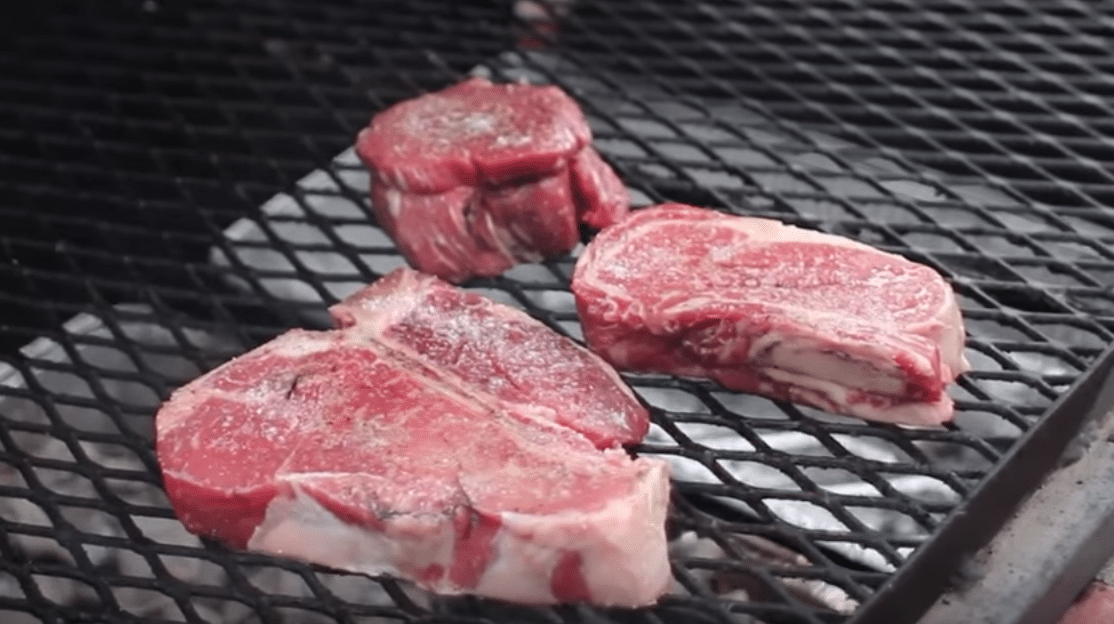Grilling season is upon us, and if you’re like many folks in the United States, you’ll likely be throwing some steaks over coal and flame in the next few months.
While I’ve eaten steak since I was knee-high to a grasshopper, I’ve got to admit that, until fairly recently, I didn’t know much about them. What’s the difference between “Prime†and “Select†steak? Why would I choose a chuck eye over a rib eye? Should I fork over extra dough for grass-fed beef?
To satisfy my meaty curiosity and find out the answers to these questions and more, I took a deep dive into the subject.
Below I share what I’ve learned.
Let’s dig in.
What Makes a Steak a Steak?
Before we begin our dive into the world of steaks, let’s begin with definitions.
Most fundamentally, what makes a steak, a steak?
Generally, a steak is a slice of meat (usually beef) that’s removed from an animal’s carcass and cuts across, or perpendicular, to the direction of the muscle fibers.
There are exceptions to this general definition. Some steaks, like skirt and flank steak (see below), are cuts of meat that are sliced parallel to the muscle fibers.
As we’ll see, steaks can come from many different parts of a cow. Where a cut of beef comes from will influence its flavor and tenderness.
How to Choose a Steak: The FAQs
When choosing a steak to cook, you’ve got a lot of options to filter through. Prime or Select? Angus? Grass fed or grain fed? Dry aged or wet aged? Sirloin steak or T-bone steak?
Which combination of the above should you get? An Angus, Prime, grass-fed, dry-aged T-bone steak?
What does that even mean?
Below we answer all the common questions that arise as you try to decide what steak you’re going to pick and cook.
What is Angus beef?
Angus refers to the breed of cattle the beef comes from. Most beef in the United States comes from Angus cattle, so the hamburger you ate for dinner last night was likely Angus beef. You’ve probably seen beef marketed as “Certified Angus Beef.†It’s just a marketing device used by the American Angus Association to promote the idea that Angus beef is superior to that which comes from other cattle breeds. To qualify as “Certified Angus Beef†the beef must come from 51% Black Angus cattle and meet 10 criteria that include the age of the cattle at harvest, the quality of the cow’s muscling, the thickness of the meat’s fat, and its degree of marbling.
Knowing your beef is “Certified Angus” does give you a guarantee of decent quality. But you probably shouldn’t worry that much whether your beef is Angus or not; it most likely is and even if it isn’t, you probably won’t notice much of a difference.
What is Wagyu and Kobe beef?
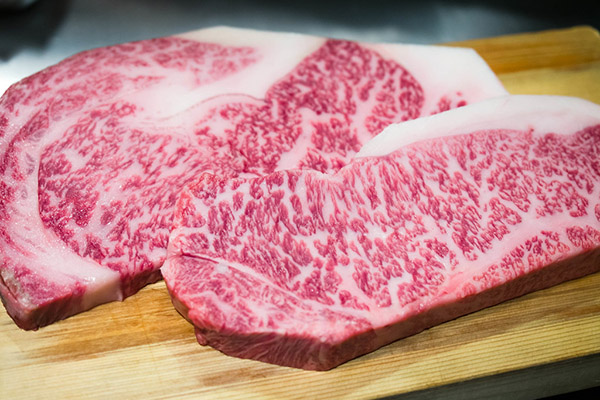
Kobe beef is a type of Wagyu beef and Wagyu beef is beef from Japanese cattle. Kobe beef is comprised of a very particular strain of Wagyu called Tajima-Gyu that is raised to strict standards in the prefecture (region/jurisdiction) of Hyogo.
What sets Wagyu beef apart from beef from other breeds of cattle is the marbling: there’s a lot of it. Thanks to years of selective breeding and a longer fattening period, Wagyu steaks have a nice, evenly distributed amount of fat. What’s more, the fat in Wagyu beef melts at a lower temperature than other breeds, which gives the meat a delicious, buttery flavor.
Kobe beef, which again, is a type of Wagyu beef, has even more marbling and tenderness than standard Wagyu beef. To be labeled as Kobe beef, cattle must meet even stricter standards concerning how the animals are raised, and the quality and marbling of their meat.
Thanks to these stringent standards, Kobe beef is expensive to produce, which means it’s expensive to buy. Retail, Kobe can cost around $100 a pound, while a 12-ounce steakhouse rib eye can set you back close to $400.
If you’re in the market for Kobe steak in the United States, pay close attention to labels. In recent years, American meat producers have been importing Wagyu cattle from Japan, cross breeding them with American Angus cattle, and labeling the resulting beef as “Kobe-style.†Kobe-style isn’t Kobe. Don’t get me wrong, domestic Wagyu beef is a good cut of beef. But it’s not Kobe.
What does the USDA grade mean?
So let’s say you’ve settled on an Angus beef. Your next choice is whether to get “Prime,†“Choice,†or “Select.†These words are used in the USDA beef scale.
The USDA grades beef according to the age of the animal and the amount of fat, or marbling, in the beef. While there are eight grades in the USDA system, a typical consumer will only encounter the following three:
Prime. This is the highest quality beef. It comes from young cattle (usually 9-30 months old). The meat has a slightly abundant to abundant amount of marbling. This is the most flavorful and juiciest grade of beef thanks to all that fat. About 3% of steaks in America are given a Prime rating.
Choice. Next in quality is Choice beef. Choice meat is high quality beef, but has less marbling than Prime beef. It’ll be a little less tender, juicy, and flavorful as a result. About half the beef in the U.S. is Choice.
Select. Select meat can still be tender, but with even less marbling than the higher grades, it’s the least flavorful and juicy.
While all beef is inspected by the USDA for food safety, grading beef is voluntary. In fact, beef producers have to pay the USDA to grade their beef. Most opt in for marketing purposes because they can claim that their beef is “USDA Prime†when selling to butchers or restaurants.
Which grade you go for will depend on your budget and what you’re looking for in a steak.
If you want something with a lot of flavor, tenderness, and juiciness, and you’ve got some discretion in your budget, go with a Prime grade steak.
If you want to save money, but still get some tasty beef, go with a Choice grade steak. It has enough fat in the meat to still give it a nice, juicy flavor. In fact, the website Serious Eats makes a compelling case that you can sometimes get better quality meat if you opt for Choice over Prime. It’s all due to some weird quirks in the USDA grading system.
Select steak is the most budget-friendly selection, but its leanness makes it an inferior choice for cooking with “dry heat†(e.g., grilling). If you do grill with it, marinate it first.
What’s the difference between grain-fed and grass-fed beef?
In recent years, there’s been a lot of talk about the benefits for consumers and for the environment of choosing grass-fed beef over grain-fed beef. But there’s a lot of misinformation surrounding these two types of meat as well.
For starters, all cattle, even grain-fed cattle, are raised on grass for the first 85% of their lives. Grain-fed cattle get moved to a feedlot and switched from a diet of grass to a diet of grain (composed of corn, soy, straw, and/or alfalfa) about three months before they’re dispatched. Grass-fed cattle maintain access to pasture and keep eating grass (along with other leaves and vegetables) all the way up until slaughter.
So rather than calling certain cattle “grain fed†or “grass fed,†it would be more accurate to label them as “grain finished†and “grass finished.â€
Eating an all-grain diet fattens cattle up quickly and imparts that nice marbling which makes their meat taste delicious. Grass-finished cattle, because of their diet and because they move their muscles more, produce a meat that’s slightly leaner and tougher.
Nutrient and health wise, grass-finished beef contains more Omega-3s, CLA, and vitamins A and E. However, the difference in these nutrients between grass-finished and grain-finished beef isn’t huge. Also, unless the meat is specifically labeled as being antibiotic free, both kinds of cattle may be given antibiotics.
As to the argument that grass-fed cattle are better for the environment than grain-fed cattle, that’s probably a wash, too. It’s been argued, but unproven, that the well-managed grazing of cattle helps keep carbon dioxide underground. But on the flip side, grass-finished cattle actually require 3X more land and water than grain-finished cattle. And because grain-finished cattle need less time to reach market weight than grass-finished cattle (several months compared to several years), the latter spend more time farting and let off 500% more greenhouse gases into the atmosphere per pound.
So pick whichever type you want and makes you feel good. There’s not going to be much difference — except in price.
Should I get a dry-aged steak?

Short answer: It depends
Short answer-pointing-to-a-longer answer: Read our article on dry-aged beef.
Dry-aged beef is labor-intensive to prepare, and thus costs more to buy. It has the moisture drawn out of it, and then undergoes what is essentially a process of controlled decomposition. The result is a steak that’s more tender, and has a richer, meatier, more buttery flavor. It’s not better than wet-aged (which is how most beef is sold to you — vacuum-packed and stored in a fridge). It’s just different.
Which cut of steak should I get?
Steaks come in a wide variety of cuts. Here’s the lowdown on each:
Bone-in Strip Steak (a.k.a., New York Strip Steak, Kansas City Strip, Shell Steak, Hotel-cut Strip Steak, or Ambassador Steak). Strip steaks are called strip steaks because they’re “stripped†from the short loin, or the cattle’s lower back. Bone-in strip steaks have the spine bones still intact in the cut. Strip steaks are very tender and juicy.
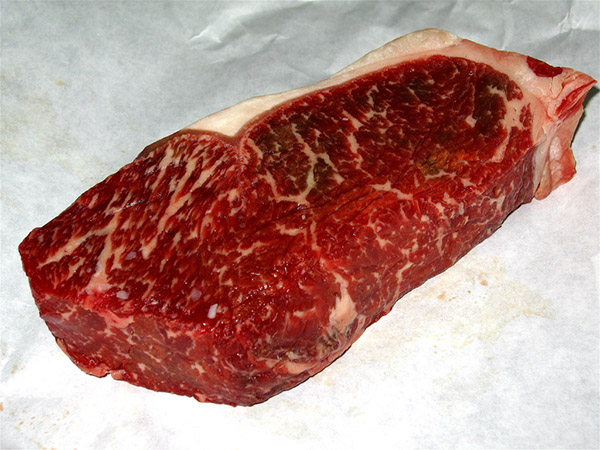
Boneless Strip Steak
Boneless Strip Steak. A strip steak with spine bones removed. One of the advantages of boneless strip steaks is that they cook more evenly than their bone-in cousins. The disadvantages of removing the bone are that you lose some flavor and the steak doesn’t look as cool when you serve it (though some diners prefer their meat entirely sans skeleton).
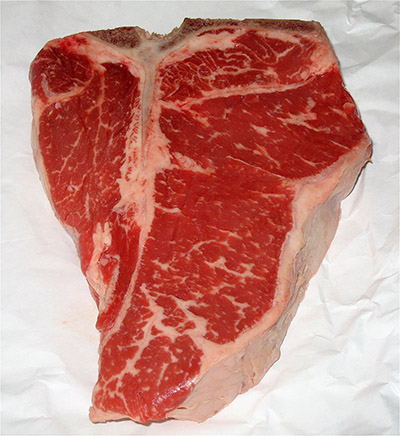
T-Bone
T-Bone Steak. Cut from the short loin across the cattle’s spine. It has sections of both the strip and tenderloin muscles that are separated by a T-shaped bone (can be seen at the top of the picture above). It’s a large cut of meat that’s tender and flavorful.
Porterhouse Steak. A porterhouse steak is a T-bone steak that contains a larger portion of tenderloin muscle. Like a T-bone, it’s tender and flavorful. It’s a great cut to share with a second person on account of how large it is.
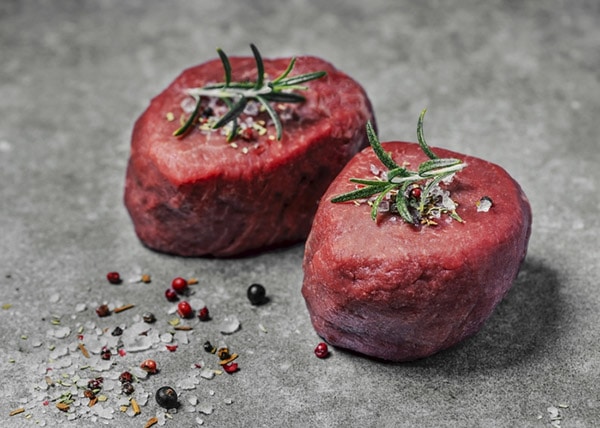
Tenderloin
Tenderloin or “Filet Mignon.†When people get a steak at a nice restaurant, they often order the filet mignon. It’s the most tender cut of meat from a cow. It’s made up of muscle fibers that run along the inside of the spine. While the tenderloin is, well, tender, it doesn’t have as much flavor on account of it being such a lean piece of meat. Consequently, a filet mignon is often served with some sort of fatty sauce.
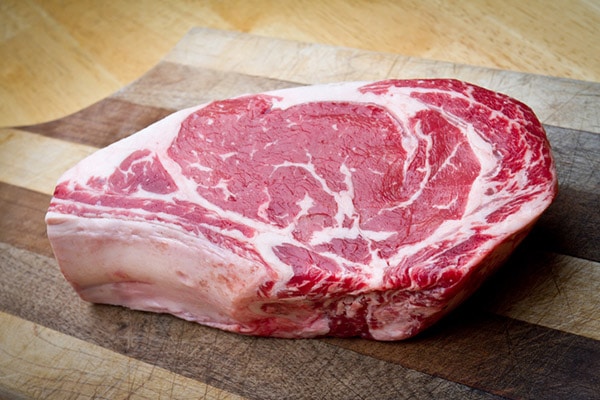
Rib Eye
Bone-in Rib Eye Steak. Rib eye steaks consist of two muscles: the loin and the cap. The bone makes the cut look even more impressive. It’s one of the most marbled and flavorful cuts of meat, which is why it’s many a butcher’s favorite.
Boneless Rib Eye Steak. Same as a bone-in rib eye, but without the bone.
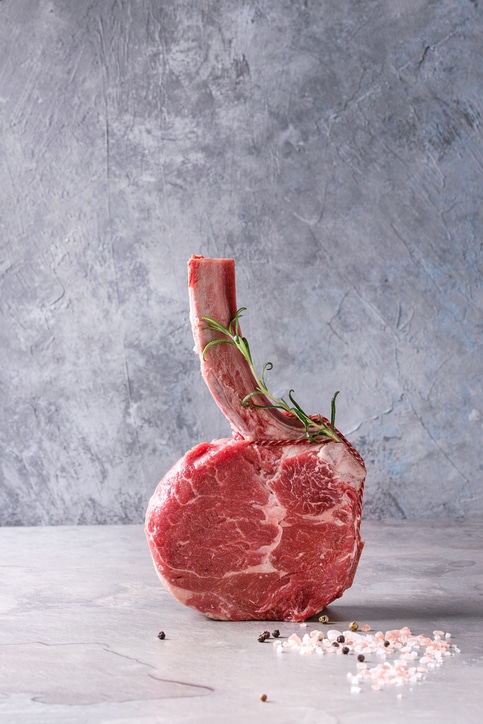
Tomahawk
Tomahawk Steak. It’s a bone-in rib eye steak with the entire bone intact. The long bone provides an impressive presentation on the plate. Nice marbling and nice flavor.
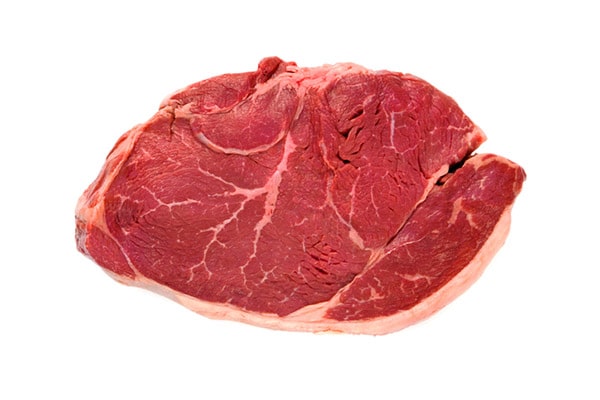
Sirloin
Sirloin Steak. Comes from the sirloin (on the back of the animal near the rump) of cattle. It’s a ho-hum cut of meat — not very flavorful or tender. It tastes like beef, and it’s affordable. That’s pretty much it.
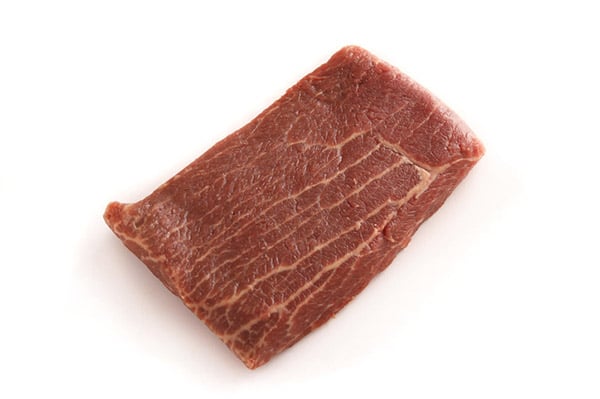
Flat Iron
Flat Iron Steak. Comes from under the shoulder blade of the animal. It’s a tender cut of meat and has the same flavor as a strip steak. The big downside of flat iron steaks is that there’s a large piece of sinew that goes right down the middle of the cut, which makes it harder to eat. To get around that, you can cut the steak in two along the sinew, remove the sinew, and cook the steak as two filets.
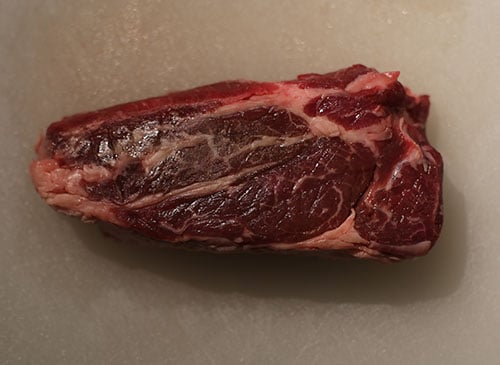
Chuck Eye
Chuck Eye Steak. This is my favorite cut of beef because it has all the tenderness and flavor of a rib eye, while being much cheaper than a rib eye. Chuck eyes come from the shoulder and are a great economical substitute for rib eye steaks.
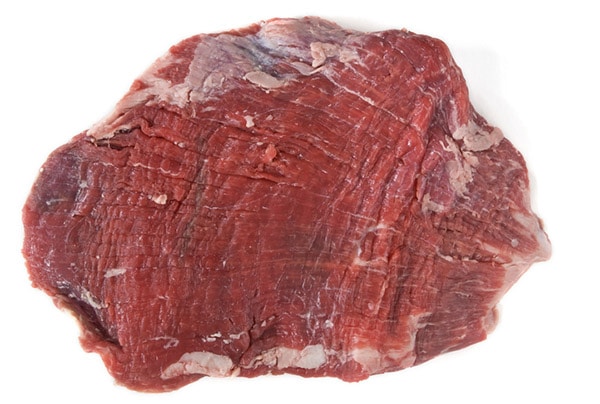
Flank
Flank Steak. Unlike most steaks, flank steaks are cut parallel, rather than perpendicular, to the muscle fiber. The cut comes from the belly of the animal, and its long muscle fibers make for a chewier piece of meat. It’s not great for grilling as a steak. Works well for fajitas, though.
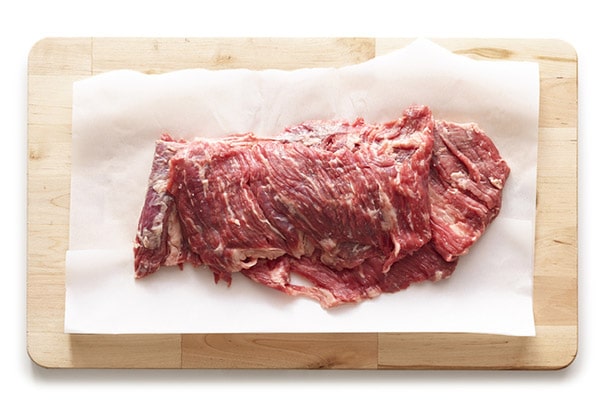
Skirt
Skirt Steak. Also from the belly and cut parallel with the muscle fiber. It’s got great flavor and is fairly inexpensive.
Best Ways to Cook a Steak
No matter how knowledgeably you choose your steak, you won’t enjoy it to the hilt if you don’t cook it well!
Below you’ll find guides on two delicious ways to cook a steak; there are other methods though, like cooking it on a shovel!
How to Grill a Perfect Steak
How to Reverse Sear a Steak

There you go. Your ultimate guide to all the essentials of steak-dom. Happy grilling. And eating.
A big source for this article was master butcher Pat LaFrieda’s book Meat: Everything You Need to Know; for more on all things meat, listen to my podcast with LaFrieda:


